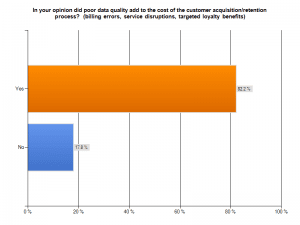A Data Quality Strategy would help IT drive a Data Quality Initiative
Why? Our research confirms that participating organizations have data quality that is poor, and the poor data quality is costing the business its customers and its profits. As shown in the graph following, 82% of our more than 400 Poor Data Quality – Negative Business Outcomes survey respondents think that poor data quality has raised the cost of acquiring new customers, and retaining existing ones. This is only one example of a data quality problem causing a negative business outcome. There were many more reported.
Click the diagram to see a larger version.
Current approaches to achieve data quality are not strategic. Instead, they are usually derivatives of some other business initiative, such as implementing a new Enterprise Resource Planning (ERP) system, undertaking a new business analytics program, or integrating a new corporate acquisition into the data mix. Clearly, the derivative approach is inadequate.
What is your data quality strategy?
Do you have a data quality strategy that addresses how you can improve your customer’s experience with your firm and how you can increase market share? Yes, you should have such a strategy, but strategy development, whether for the corporation as a whole, or for data quality, can be fraught with challenge.
For example, a data quality strategy focused on building elaborate data quality improvement plans that have no business champion, no funding, and no top-line focus will be a loser. Directing IT to control the costs of poor quality data in a situational approach won’t qualify as a winning data quality strategy either. Customer focus and top-Line success will lead you to the right track.
Do you believe your poor data quality situation is vast and abysmal? You are probably right. Do you believe the data quality improvement technology environment is challenging to understand, with no clear road-map about which technology bit solves which problem? You are right again. However, if you think that, in the face of these realities a data quality strategy would be a waste of time, you would be wrong.
True strategy is about placing bets and making hard choices. The objective is not to eliminate risk but to increase the odds of success. Roger L. Martin
If you are thinking about elaborate data quality strategy plans or waiting to see what your data quality strategy should be, perhaps you have come under the spell of “The Big Lie of Strategic Planning”. Writing in the Jan-Feb 2014 issue of the Harvard Business Review (HBR), Roger L. Martin discusses strategic planning in the larger organizational sense, but his insights apply to subordinate strategy initiatives like data quality, as well. With the right subscription, you can read Martin’s article here. Roger L. Martin is a professor at the Rotman School of Management at the University of Toronto.
Avoid these Traps with your Data Quality Strategy
 Martin discusses three primary strategy traps that snag corporate strategists. They are
Martin discusses three primary strategy traps that snag corporate strategists. They are
- Avoiding fear of the unknown by substituting elaborate planning for betting on a future course
- Considering cutting costs and squeezing profits from existing revenues instead of entering new markets and adding new customers
- Taking a situational or “emergent” approaches to strategy development that devolve into tactical responses to ongoing market forces
These could be traps for professionals building a strategy to improve data quality. Remember the “Enterprise Data Model” that required a huge budget and an army of data analysts yet never reached completion or produced value? Initiatives like that required elaborate planning, but delivered work products that were generally dead on arrival.
Driving the costs out of data management budgets and doing more with less are also losing approaches to a data quality strategy. A successful strategy will target improvements in the business top line, meaning more revenue, new customers, entrée into new markets, and similar approaches.
Finally, doing nothing different and taking a situational and reactive approach is certainly a loser. Continual application of tactical band-aids made poor data quality a systemic problem for which simple penicillin is no longer effective.
A Modest Proposal for a Data Quality Strategy
The essence of your data quality strategy is to stop future data quality problems, and clean up or minimize the existing ones, in a directed, systematic, and visible way. It is a classic divide and conquer approach. Part one of your strategy is to find and fund a project with the right business partner. However, a single victory in a single project will only be the start. A strategic data quality victory will come when multiple projects with strong executive partnerships succeed, and the success is communicated. Plan on your string of projects being spread over several years.
At the start of this post, I referenced a poor customer data quality finding from our research. I can tell you that our study participants have had negative business outcomes from poor data quality across the spectrum of functional business areas, ranging from finance to supply chain. Eliminating data quality problems in these areas will also be part of your strategy, but you will achieve data quality strategy success faster if you start with business areas that contribute directly to the top-line. That said, here is how to get started.
Partner with your business colleagues to build a case for data quality. If your data quality strategy is an IT initiative with no business support, it is unlikely to produce sustained success. Ensure that you have a respected and visible business executive in your corner. Most IT executives are evaluated on their ability to manage costs, but a great data quality strategy is not about controlling costs. Instead it focuses on making existing customers, adding new customers, and entering selected new markets. These are business concerns that demand IT support. Hence, a partnership is critical.
Identify and act on a visible, revenue-producing data quality improvement opportunity. Don’t boil the ocean, but do work with your business executive partners to find an opportunity that adds to the top line, improves customer satisfaction, or drives a new market penetration opportunity.
Pick an opportunity that shows results horizon of one year or less. Rapid success that makes a top line improvement will be noticed, and you will attract more partners. When you are starting out, a very long payback period will be very uninteresting to the business, placing your initiative at risk.
Ensure your business partners measure the revenue increase, new customer adds,  existing customer business increase, and similar top-line results that derive from successfully implementing your data quality strategy. You can also build a data quality baseline and track some practical data quality metrics. Do this and you will have sound answers for your IT colleagues as well as your business peers.
existing customer business increase, and similar top-line results that derive from successfully implementing your data quality strategy. You can also build a data quality baseline and track some practical data quality metrics. Do this and you will have sound answers for your IT colleagues as well as your business peers.
Don’t keep your success a secret. Work at attracting new business partners for whom you can work the same top-line magic. Ask your executive business partner to introduce you to his or her peers. There is nothing like a sincere endorsement, backed up by numbers, to attract new data quality strategy participants. Individual organizational cultures will determine whether there are other outreach mechanisms, such as company newsletters, all-hands meetings, monthly meet-and-greet sessions, or others. Use all relevant and culturally appropriate channels to get the word out.
Get busy with finding the next strategic project. Don’t sit on your laurels. Yes, your success is sweet, but now is the time to work with your executive business partner to engage his/her colleagues and get the next initiative on line. Remember that your data quality strategy initiative won’t succeed without a driver, and that driver is you.
The Bottom Line
Your poor data quality is not likely to improve itself, so don’t wait around for that to happen. Instead, develop a pragmatic data quality strategy that partners with your business peers, addresses their top-line success, customer satisfaction, and new customer additions. Measure your success and let your business colleagues know, in a culturally appropriate way, and you will be well on your way to eliminating the Poor Data Quality – Negative Business Outcomes effect that so many of your peers are experiencing.
Principal Consulting and The Robert Frances Group are ready to help you, from building your data quality strategy to letting your world know. Contact us today to get started.
